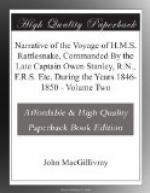Now, this analysis of the Kowrarega personals has exhibited the evolution of one sort of pronoun out of another, with the addition of certain words expressive of number, the result being no true inflexion but an agglutination or combination of separate words. It has also shown how the separate elements of such combinations may appear in different forms and with different powers in different dialects of the same language, and different languages of the same class, even where, in the primary and normal signification, they may be wanting in others. The first of these facts is a contribution to the laws of language in general; the second shows that a great amount of apparent difference may be exhibited on the surface of a language which disappears as the analysis proceeds.
In rude languages the Numerals vary with the dialect more than most other words. We can understand this by imagining what the case would be in English if one of our dialects counted things by the brace, another by the pair, and a third by the couple. Nevertheless, if we bear in mind the Greek forms Thalassa and Thalatta, we may fairly suppose that the Kowrarega word for two, or quassur, is the same word with the Head of Australian Bight kootera, the Parnkalla kuttara, and the Western Australian kardura, having the same meaning.
The difference, then, between the numerals of the Australian languages—and it is undoubtedly great—is no proof of any fundamental difference of structure or origin. It is just what occurs in the languages of Africa, and, in a still greater degree, in those of America.
The extent to which the numeration is carried, is a matter of more importance. Possibly a numeration limited to the first three, four, or five numbers is the effect of intellectual inferiority. It is certainly a cause that continues it. As a measure of ethnological affinity it is unimportant. In America we have, within a limited range of languages, vigesimal systems like the Mexican, and systems limited to the three first units like the Caribb. The difference between a vigesimal and decimal system arises simply from the practice of counting by the fingers and toes collectively, or the fingers alone, being prevalent; whereas the decimal system as opposed to the quinary is referrible to the numeration being extended to both hands, instead of limited to one. Numerations not extending as far as five are generally independent of the fingers in toto. Then as to the names of particular numbers. Two nations may each take the name of the number two from some natural dualism; but they may not take it from the name. For instance, one American Indian may take it from a pair of skates, another from a pair of shoes. If so, the word for two will differ in the two languages, even when the names for skate and shoe agree. All this is supported by real facts, and is no hypothetical illustration; so that the inference from it is, that, in languages where a numeral system is in the process of formation, difference in the names of the numbers is comparatively unimportant.




